Over forty willing volunteers met at the Bluebird Café car park to carry out Ferring Conservation Group’s first beach clean of the year with help from the youngest volunteer to date, Sophia, at almost three years old. The group spread along the beach as far as Sea Lane with some volunteers working along the shoreline while others concentrated on the foreshore area. 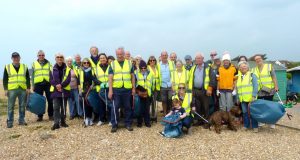 The usual items were collected, mainly small pieces of plastic, fishing line, nylon rope etc., plus a small number of larger items. The small items collected are just as important to remove as these can easily be ingested by marine life as well as wading birds. The strangest item found was an arrow head in the beach hut area and it is hoped that no living thing was used as target practice.
The usual items were collected, mainly small pieces of plastic, fishing line, nylon rope etc., plus a small number of larger items. The small items collected are just as important to remove as these can easily be ingested by marine life as well as wading birds. The strangest item found was an arrow head in the beach hut area and it is hoped that no living thing was used as target practice.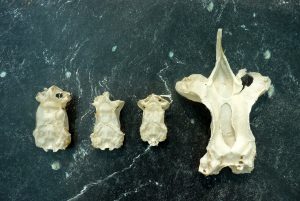 Unusually there were many cartilaginous shark skulls found entangled in seaweed along the shoreline – the skeleton of these sharks are made entirely from cartilage.
Unusually there were many cartilaginous shark skulls found entangled in seaweed along the shoreline – the skeleton of these sharks are made entirely from cartilage.
Group Meeting – 31st May 2019
Sussex ecologist Laurie Jackson gave a talk to Ferring Conservation Group on 31 May on ‘Looking after our Wild Pollinators’. She said most fruit and vegetable crops depended on insects to carry their pollen to the ovaries of another plant of the same species and that insect populations are falling rapidly, raising real fears of falling yields. If these crops had to be pollinated by hand it would cost billions of pounds a year and make it impossible to grow them at prices that people could afford. Wild flower populations were also at risk.
She said honey bees were very useful in pollination but they were only one of 4,000 species of insects in the UK that carried out this essential process. Solitary bees and bumblebees were actually more efficient than honey bees and flies, especially hoverflies, were more efficient still. Butterflies, moths and beetles were also important pollinators.
Conservation Group members were urged to help insects to survive – by planting the right sort of plants, and leaving a part of their garden ‘untidy’ where insects could live undisturbed, and by creating refuges where insects could shelter, over-winter and reproduce. Modern farming methods were largely to blame for the loss of so many insects but everyone could do something to help the wild pollinators to continue their essential work.
Members also had a round-up of local wildlife news from Tricia Hall, including sightings of water voles on Ferring Rife, Whitethroats and a Red Kite. Ed Miller gave his report on current planning applications – he said there had been a run of applications to convert bungalows into two-storey houses – and Chairman David Bettiss gave an update on forthcoming events, including two trips out by boat to see the Rampion Windfarm at close quarters.
Group Meeting – 26th April 2019
Tricia Hall, the Group’s wildlife expert, delivered a fascinating reflection on a recent holiday in Bulgaria in an illustrated talk entitled ‘Birds, Butterflies and Bears’. Accompanied by her good friends Charles and Eileen Cuthbert, they flew from Gatwick to Sofia, the nation’s capital, for the start of a wildlife holiday that did not go exactly to plan. They were met by their kind and generous (but not very knowledgeable) guide, Kosta, and soon found that they were the only participants on the holiday. Kosta drove them east in a minibus stopping en-route to see butterflies where they were rewarded to see several Black-veined Whites (extinct in Britain since the 1920s).
Their first hotel was in the town of Koprivishtitsa, built in the typical style of the town with little wooden balconies and thin walls. Many of the houses there are ’National Revival’ houses and are colourfully painted. This town is also the location of the momentous April Rising of 1876 against the Ottoman rule and on a hill above the town there is a memorial to mark the event. Many Spotted Flycatchers were seen here and under a bridge Dippers were seen in the river feeding their young.
The next day they headed along the main road and visited a stunning meadow which was full of flowers: Catchflies, Vetchlings, Trefoils, Plantains and thousands of Yellow Rattles. A day-flying Speckled Yellow moth, a Boletus species and a large Bush Cricket were found, also Cuckoos, Yellowhammers and Chiffchaffs could be heard calling. There were many more highlights on the trip including an unexpected visit to a grim housing block, from the days of Soviet occupation, where Kosta’s mother had prepared a typical Bulgarian tea for them.
After an arduous trek in a four-wheel truck up a mountainside for their bear watch, many hours were spent in a small hide near to areas baited with maize, apples and fish. This eventually paid dividends when firstly a small bear came into view and then at dusk a large European bear made an appearance, but unfortunately it was already too dark to photograph it.
A further unscheduled visit took them to a Tortoise breeding area. These tortoises were mostly rescued, unwanted pets and were kept in pens on the dry slopes above the marshes and Tricia, Charles and Eileen were able to hold some of the babies. Towards the end of the holiday they found themselves near to the Serbian border where Kosta was stopped by police in case he was transporting illegal immigrants!
Upon their return to Sofia ready for their flight home they were saddened to see many buildings covered in graffiti, including the holiday company’s premises, but this did not deflect from their thorough enjoyment of the holiday.
A short AGM followed where existing committee members were re-elected unopposed.
In lieu of the regular Nature Notes slot an interesting short film was shown about the work of Ferring Country Centre made by the late Mike Hall.
To conclude the meeting Ed Miller updated the Group with the latest planning news: the ASDA application for a 24 hour extension during the Christmas period was approved by Arun DC along with the extension to the Yeoman’s premises along the A259 in Ferring. Also Quercus Nurseries have applied for a variation to extend the time they can receive deliveries.
FCG’s Bluebell Walk in Clapham Woods
On a morning that was bright and clear, but a bit chilly, members of Ferring Conservation Group recently travelled the short distance to Clapham Woods (just off the Long Furlong road) for a woodland bluebell walk ably led by Group committee member,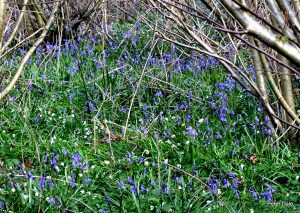 Graham Tuppen.
Graham Tuppen.
Setting off across the fields by the village church, the group was soon in the woods, where the display of bluebells and particularly wood anemones could be seen in all their glory. The bluebells were probably a week or so from their best, but the anemones were undoubtedly at their peak and formed a dense carpet. Plenty of other woodland plants were identified, including the delicate greater stitchwort, dog’s mercury, wild strawberries, lords-and-ladies, dog-violets and even the first flower spikes of early-purple orchids. It was a most enjoyable guided walk, and in addition to the plants some magnificent tree examples were seen including a massive beech tree, which it was estimated must be hundreds of years old.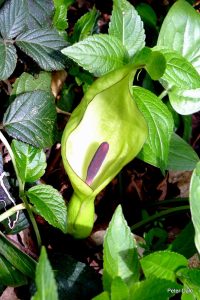
The group was also lucky enough to hear and see a variety of woodland birds. Many of these were the usual suspects, such as blue tits, robins and pheasants, but a number of nuthatch were heard calling throughout the walk and eventually seen in the oak tree in the car park. The prize for the best sounding bird though must have been the mellifluous song of the mistle thrush.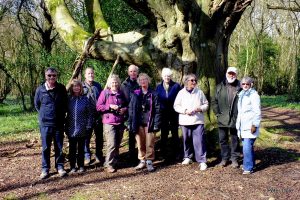
A visit to these woods, especially at this time of year, is fully recommended as a welcome escape into our local natural environment.
FCG’s Clean Up of the Rife
Ferring Conservation Group’s annual clean-up of the banks of the Rife took place on Saturday 23rd March. Around twenty five members, including two keen junior members, 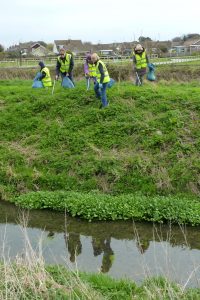 met in the Bluebird Café car park and as in previous years once the usual litter pickers, hi-vis jackets and black bags had been issued the group formed two teams with each team working in parallel along the east and west banks.
met in the Bluebird Café car park and as in previous years once the usual litter pickers, hi-vis jackets and black bags had been issued the group formed two teams with each team working in parallel along the east and west banks.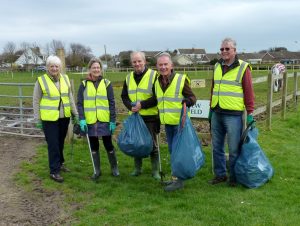
Owing to the exceptionally early warm weather this year, the nettles along the banks had already grown making it more of a challenge to spot litter in the foliage but this didn’t pose a problem for Eoin Kearns, the youngest member of the Group, as his keen eyes found many items and he soon completely filled his sack. Around twenty bags of litter were collected in all, with the majority of items found on the east bank in the bushes and down the footpaths. Along with the 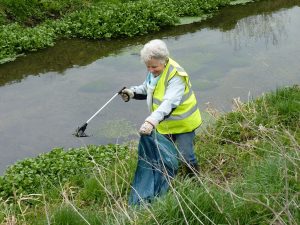 usual types of litter a child’s cushion and a pair of shorts (probably discarded by a playful fox) were collected and signs of spring were seen along the way including a Small Tortoiseshell butterfly and a Bumblebee.
usual types of litter a child’s cushion and a pair of shorts (probably discarded by a playful fox) were collected and signs of spring were seen along the way including a Small Tortoiseshell butterfly and a Bumblebee.
The Rife in Ferring is a haven for wildlife including Little Egrets, Moorhens and Water Voles, also many wildflowers can be found along the banks making this area an important wildlife sanctuary. Therefore it is important that all visitors respect this and take their litter home with them or place it in the bins provided in the Bluebird Café car park or at Ferring Country Centre.
FCG Visit to Pagham Harbour
At the end of March, a party of Ferring Conservation Group members made their way to the Pagham Harbour Nature Reserve for their annual spring time visit and in order to savour all that the area has to offer in terms of wildlife and tranquility. The day was led as normal by member and local bird expert, Clive Hope, whose skills allowed us to spot and identify a large variety of birds and other animals.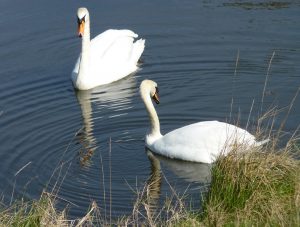
In total, a very impressive 40 different bird species were seen around the area of the North Wall, including some which had just arrived in the country after their migratory journey. One Chiffchaff for example was seen and heard in the top of a tree, both singing loudly and catching insects at different times.
Many of the usual suspects were found, including Curlew (a large flock of over 30 seen in an adjoining field) Black Tailed Godwit, Redshank and Little Grebe amongst others, and views of Buzzards and Kestrels as well. The strident call of a Cetti’s Warbler was heard several times, a couple of Mute Swans treated us to a low-level fly past before landing on the nearby water, and several Grey Herons were seen moving in and out of the regular Heronry nest site. We even saw a Roe Deer moving across the fields to the north.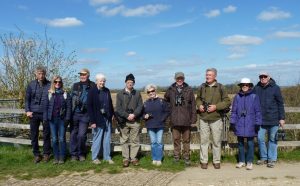
After a couple of hours taking in the sights, we repaired to the nearby café for a spot of lunch before a brief visit to Pagham beach where some of the highlights were Great Crested Grebe and a close-up Brent Goose swimming near the water’s edge. On the way home, we noticed a large number of signs put up by local people protesting at plans to build housing estates in this precious area. What an absolute tragedy this would be for such a special place with the likely harm to the wildlife that it attracts. We do have something in common with Pagham though, as it seems that we in Ferring are also constantly under attack by predatory developers!
Group Meeting – 29th March 2019
For their March meeting Ferring Conservation Group welcomed Mike Russell a former Sussex Wildlife Trust warden at Woodsmill, and although now retired Mike still helps out there on occasion. Mike gave an interesting and informative talk entitled ‘The Wonder of Migration’ illustrated with many excellent photographs.
Mike began by explaining that bird migration is all about survival. Land areas change with the seasons and what may seem like a perfect summer home can become a death-trap in winter. Unfortunately most insects disappear in winter during cold weather whereas in the warm climate of Africa there is an endless supply. The urge to migrate is stimulated by the change in temperature, lengthening daylight, the urge to breed and prevailing conditions in wintering grounds. Birds prepare for migration by spending many hours stocking up with food ready for the long journey ahead and their bodies have a special ability to turn food quickly into fat. The fat forms a layer beneath its skin, which is converted into energy as the birds fly and this gives them enough strength to migrate all the way to Africa.
A spell of calm weather with clear skies is usually the signal to start migration and birds navigate by using the position of the sun and stars with most birds migrating at night. Using the magnetic fields to guide them to familiar landmarks and traditional stopping off points and genetic imprinting enables birds to instinctively know to fly south. Birds have to deal with all kinds of dangers on the way – from bad weather and predators to exhaustion and starvation. Storms at sea can drive birds into waves where they drown and sandstorms or wildfires can cause similar problems.
Over one million birds have been ringed in the UK, 41,600 here in Sussex in an attempt to learn more about this incredible wonder of the natural world and Mike surprised the audience by explaining that the concept of bird migration is relatively new. It is only a hundred years or so since people have come to recognise this bird behaviour but even with all the advantages of modern technology, we still have lots to learn.
Tricia Hall followed the break for tea with her Nature Notes slot and advised the Group that the many trees planted along the banks of the Rife are looking healthy. She suggested that the vegetation that had grown up between the trees should be left to encourage birds to breed. Bees had been seen feeding on Blackthorn blossom and Celandines, Red Nettle, Daisies and Speedwell were all looking pretty around the village. Tricia had also noted that the leaves on the willow trees in Little Paddocks were already visible and the Cormorant had once again taken up residence there. Also many Greater Spotted and Green Woodpeckers had been seen and heard in the Plantation at Goring and a Reed Bunting had been heard along the Rife.
Ed Miller concluded the meeting by keeping the Group up to speed with planning news and informed the audience that the planning application for the demolition of a 2 bed bungalow and the building of a 2 bed house at 11 Ocean Drive had been refused by Arun DC. There is a new application for a 10th apartment at Southpoint in South Ferring; a proposal for a house to be built in the side garden at 30 Rife Way and a bungalow to be built in the back garden of 2 The Grove. A revised plan for a smaller bungalow to be built in the garden of Elm Lodge in Tamarisk Way has also been submitted to Arun. ASDA have submitted an early application to secure 24 hour opening over the next Christmas period. Ed also advised the Group that appeals were still pending at 4 Sea Lane, 11 Telgarth Road and 21 Ocean Drive.
FCG’s Latest Activities
Beach Walk
On February 26th, a glorious sunny day, twelve members of the Conservation Group met at the south end of Sea lane in Ferring for a walk to Goring. An initial excitement was the spotting of a Merlin, our smallest raptor. David Cambell, a local expert, pointed out the bird which was sitting in a tree half way up Sea Lane. This is a very unusual sighting for the Gap and illustrates just how important this green space is for birds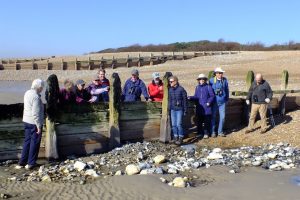 .
.
We set off towards the sea which was a long way off and the going was tricky with slippery rocks and pools of water. We stopped to examine the end of a breakwater which revealed a mini habitat of Spiral Wrack, Cladophora (a green seaweed), Common Limpets, Barnacles, Mussels and Periwinkles. We searched under rocks and collected a variety of organisms stranded on the beach. This flotsam included Ray and Shark egg cases, Cuttlefish ‘bones’, Slipper Limpets and other mollusc shells and the colonial animal Hornwrack which looks like a dried seaweed.
We eventually abandoned our efforts to reach the sea and made our way to the Sea Lane cafe for coffee along the top path. On the return trip, the sea was coming in and so we were able to observe Oystercatchers, Dunlin and Sanderling on the tide line and Turnstones camouflaged against the rocks.
Presentation of cheque to Chestnut Tree House Hospice
Artist Tricia Hall painted a Christmas card of Ferring for members to purchase at their meetings. It featured the beach huts in the snow. Many of the cards were also sold by Margaret Metcalf at St. Andrew’s Church after Sunday services.  A total of £560 was raised and the cheque presented to Chestnut Tree house Hospice by Tricia and our chairman, David Bettiss. Many thanks to everyone who bought cards and thus contributed to this worthy cause. This is the eighth year that we have supported this charity through the sale of Christmas cards.
A total of £560 was raised and the cheque presented to Chestnut Tree house Hospice by Tricia and our chairman, David Bettiss. Many thanks to everyone who bought cards and thus contributed to this worthy cause. This is the eighth year that we have supported this charity through the sale of Christmas cards.
Conservation Work
Nine members met on the Village Green for their regular 1st Tuesday of the month conservation work.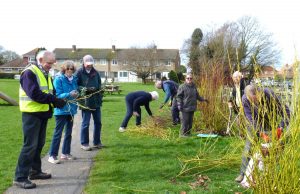 This session involved the trimming and cutting back of various shrubs and weeding the herb bed. If any other members would like to join this group, they would be very welcome.
This session involved the trimming and cutting back of various shrubs and weeding the herb bed. If any other members would like to join this group, they would be very welcome.
A ‘Medieval’ Herb Bed
As a contribution to St. Andrew’s Church’s 1250 anniversary, FCG have constructed a herb bed based on a cartwheel design. The bed is on the village green and is just in front of the children’s playground. The bed is for fun but we hope to provide informative labels and the herbs have been selected for their attractiveness to bees and other insects.
We have planted medicinal herbs which were made into tonics, potions, purges and salves (ointments). Feverfew, for example, was used to treat headaches and was also for joints and digestive problems. It is also a good nectar and pollen source for bees.
Dyeing plants were those from which the medieval housewife extracted dyes for colouring cloth. Woad was an important source of blue dye and was used to colour clothes and tapestries and was also a pigment for blue paint.
A thousand years ago homes, of both poor and rich people, were remarkably smelly and dirty. Strewing plants were those that were scattered on floors, with rushes or reeds, to mask smells and keep insects at bay. The rushes and reeds helped to soak up all manner of spilt liquids (animals usually shared the homestead), but, were often only changed twice a year! Lavender was strewn on floors for this purpose and was supposed to repel moths. It was also a personal scent and was used in baths when one was lucky enough to get one!
We have planted many culinary herbs which were used in cooking and most of these are familiar to us today. These had important other uses as well so the medieval housewife had to be very knowledgeable. It was her duty to sow, plant and tend her garden. Mint, for example, was an aid to digestion and was made into a sauce. It was also used for cleansing wounds, as a cough mixture, and was added to vinegar to make a mouthwash. It also deterred vermin.
We are grateful to Benton Weatherstone who gave us free bricks for the construction, Ferring Nurseries for the compost and Culberry Nurseries at Angmering for their advice and providing many of the herbs at very reduced prices.
Please come along to see our herb bed and watch how it develops. When it is growing well, we may even allow you to snip a few herbs for your own use as long as you promise to pull out half a dozen weeds at the same time!
Worthing Conservation Volunteers
The above group which carries out excellent practical conservation work around the Worthing area are looking for more volunteers to help them. Their regular work parties start at 10am and end by 3.30pm on the designated day, but they welcome any help at all for however long.
The next work party is on Sunday 17 March at Cissbury Ring, where they will be working with the National Trust warden to maintain the chalk downland flora.
For further details and also to confirm venue and meeting place of each work party, please contact Jay on 01903 762064.
Group Meeting – 22nd February 2019
Andrew Cleave MBE is a Hampshire based natural historian with a lifelong passion for wildlife and has written over 20 books on natural history and co-authored many more. Andrew was given a warm welcome to Ferring Conservation Group’s February meeting and gave a fascinating, illustrated lecture entitled ‘Life between the Tides’ to this well attended event. Andrew explained how fortunate we are in Britain to have an opportunity to see and study many species of sea life exposed on our beaches at low tide. Andrew demonstrated how privileged we are to have access through rock pools and rocky shorelines to observe sea creatures and learn about their habitat and behaviour, illustrated with many superb photographs that he had taken over the years. A number of these photographs were used in the Collins Complete Guide to British Coastal Wildlife.
The rise and fall of the tide is due to lunar influences but not all seas are subject to these stimuli. Neither the Mediterranean nor Baltic seas are tidal so therefore they keep their secrets hidden, and it is only the intrepid diver or adventurous snorkeler that is privy to this captivating world.
The sea life found in rock pools at low tide must be tough and adaptable to the force of the waves and the changes in temperature as the water remaining in the pools will heat up at low tide. Seaweeds are a good example of this as these non-flowering plants glue themselves to rocks and can withstand the tidal forces. The Common Blenny is a small fish that is abundant in rocky coastal inshore waters around the UK (sometimes referred to as the Shanny), and being out of water is not a problem provided the environment is damp and moist. The Greenleaf worm, Sea Slugs and Periwinkles can all live out of water for a length of time and the round shell of the Flat Periwinkle enables these adaptable creatures to roll around in seawater and not get damaged. The many species of crab are always an interesting discovery as they are found in numerous shapes and sizes and can be easily found hiding under rocks and will scurry quickly away if disturbed. Interestingly creatures such as the Limpet have teeth that consist of the strongest biological material ever tested and they use these to cling on to a rock at low tide. Our glimpse into this captivating world is available to all those that are interested to take a look and marvel at what ‘Life between the Tides’ can reveal.
Tricia Hall presented her popular Nature Notes after the usual break for tea and advised the audience that Tawny Owls had been heard in several areas of the village and encouraged members to record any sightings of these birds on the RSPB website. Tricia reported that several signs of spring were evident with Celandines, Primroses, Snowdrops, Rosemary and White Heather covered in Honey Bees feeding on nectar had been spotted, as well as frog spawn in ponds and the lagoons near the Rife. Many birds had been heard singing in the area including Blackbirds, Song Thrushes, Dunnocks, Great Tits and Chaffinches as well as signs of birds starting to nest.
To conclude the meeting Ed Miller updated the Group regarding the latest planning news. Ed advised the audience that the recent planning application for two houses in the back garden of 21, Ocean Drive had been refused by Arun DC along with the proposed Bluebird Café expansion. The ninth apartment at Southpoint in South Ferring had been approved by the Planning Inspectorate after an Appeal by the developers.
